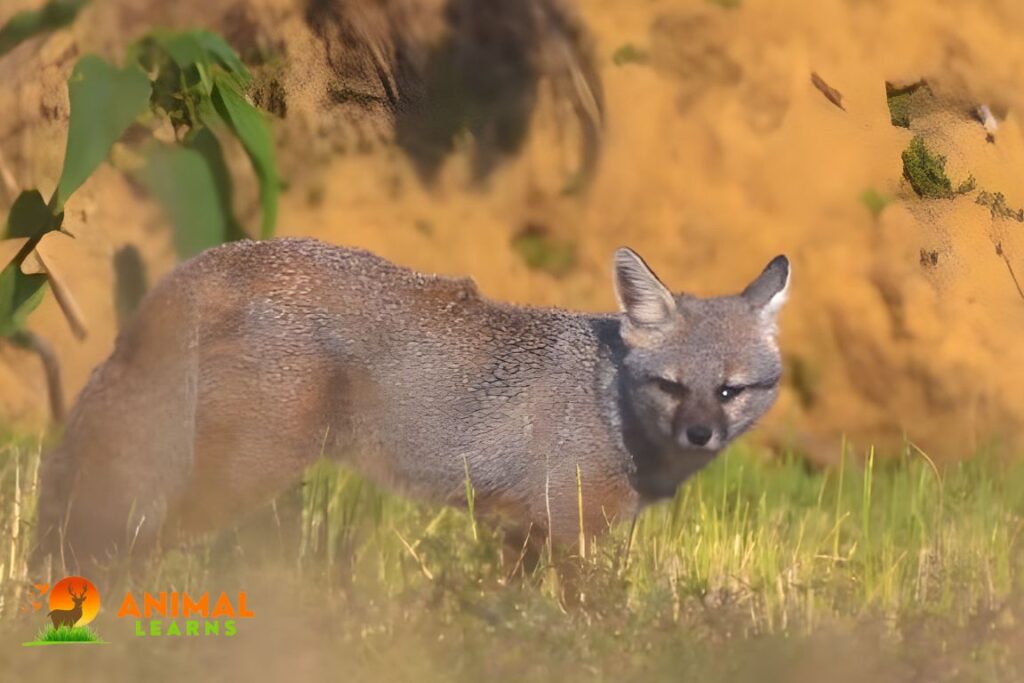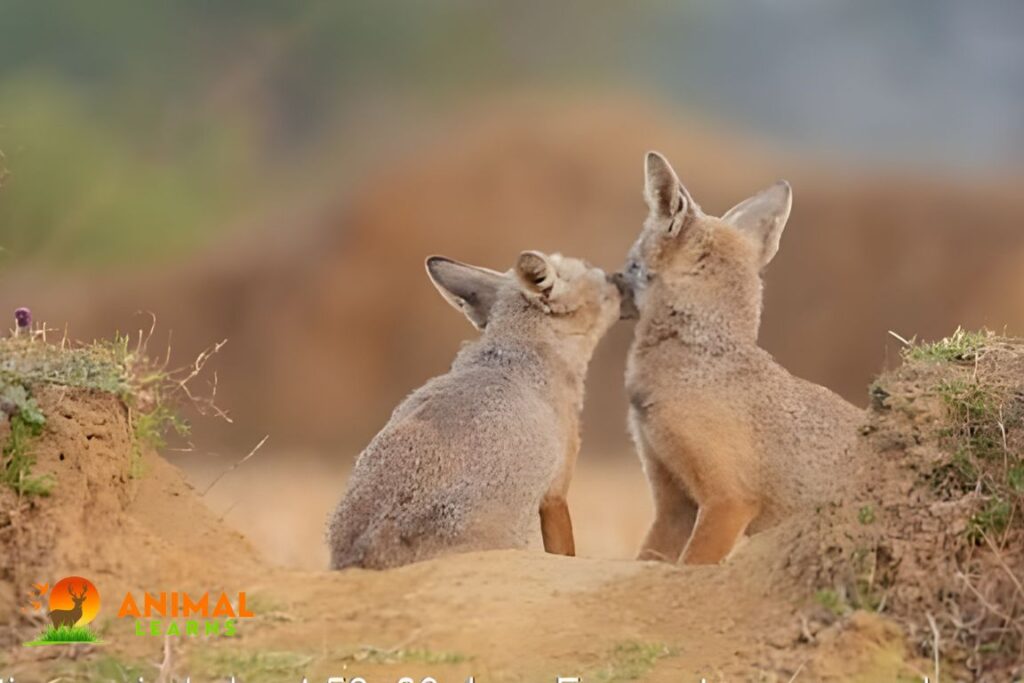Bengal Fox: Types, Interesting Facts, and Pictures

| Attribute | Information |
| Scientific Name | Vulpes bengalensis |
| Size | Small to medium-sized (about 15-20 inches) |
| Weight | Typically 2.2 to 4.4 pounds (1-2 kilograms) |
| Color | Grayish-brown to rufous with a white throat |
| Diet | Omnivorous: small mammals, birds, insects, fruits, and plants |
| Running Speed | Approximately 30-40 mph (48-64 km/h) |
| Location | Indian subcontinent, including India, Nepal, Bangladesh, and parts of Pakistan and Sri Lanka |
As a canid species, the Bengal fox graces the vast Indian subcontinent’s landscapes with their captivating and enigmatic presence.
The Bengal fox, in contrast to the Canadian Marble Fox and Arctic fox, is a small fox species native to the Indian subcontinent, known for its distinctive habitat and appearance.
Naturalists and wildlife enthusiasts have long been intrigued by the diminutive yet remarkable creature due to its distinctive rust-colored fur, sleek physique, and keen, predatory glint in its amber eyes.
I am honored to be able to shed light on the Bengal fox’s behavior, habitat, and ecological significance as a professor with extensive knowledge of the animal kingdom. All of these factors contribute to the rich tapestry of life within its native habitat.
History of Bengal Fox
Contents
In Indian subcontinent landscapes, the Bengal fox (Vulpes bengalensis) has developed a rich history that is intertwined with the landscapes. Despite being found in arid deserts and agricultural lands, this small to medium-sized canid has inhabited the region for centuries.
Bengal foxes have thrived throughout India, Nepal, Bangladesh, Pakistan, and Sri Lanka for hundreds of years because of their cooperative social structures and nocturnal behavior.
Their omnivorous diet, consisting of small mammals, birds, insects, fruits, and plant matter, illustrates their flexibility as opportunistic feeders. Human activities have caused habitat loss and disease outbreaks to threaten their populations.
It is imperative that conservation efforts are implemented to ensure their continued existence and their vital role in local ecosystems.
The appearance

A lion’s golden mane has an elegant, iridescent pattern on its wings, while a butterfly’s wings have intricate, iridescent patterns. Animal appearances are a testament to evolution’s wonders. Camouflage, mating displays, and environmental adaptations are some of the functions of these external features.
Characteristics
- There are several characteristics that define an animal’s identity, including physical attributes and behavioral traits.
- Sensory organs, body shape, and color can be considered physical attributes.
- Communicative methods, reproductive methods, and locomotor patterns are all behavioral characteristics.
In response to their ecological niches, these traits vary greatly among animal species.
Diet
A creature’s diet plays a fundamental role in its biology. It includes the types of food it consumes, the ways it obtains its food, as well as how diet fits into its ecological niche.
Animals display a wide spectrum of dietary preferences, ranging from herbivorous animals such as elephants to carnivorous animals such as sharks. Omnivores, such as humans, eat a variety of foods.
Habitat And Distribution
The Bengal fox, scientifically known as Vulpes bengalensis, is a small and elusive species native to the Indian subcontinent. These captivating creatures exhibit a remarkable level of adaptability to various ecosystems, making them a true testament to nature’s versatility.
Their slender bodies, measuring around 40 to 60 cm in length and weighing approximately 2 to 4 kg, allow them to navigate diverse terrains, from arid deserts to grasslands and agricultural areas. Bengal foxes are known for their distinctive vocalizations, often communicating with a series of barks and howls to establish their presence and territory.
With an average lifespan of 4 to 6 years, these foxes play a vital role in their ecosystems by controlling rodent populations and scavenging for food. Species have specific habitats and distributions, and their distributions are influenced by factors such as climate, geography, and resource availability.
Habitat and distribution are intimately linked to an animal’s ecological niche. Conservation efforts and understanding an animal’s role in ecosystems depend on understanding its habitat and distribution.
Behavior And Lifestyle

An Indian fox is a small to medium-sized canid native to the Indian subcontinent called the Bengal fox. A Bengal fox eats omnivorous foods such as small mammals, birds, insects, fruits, and plant matter. They are primarily nocturnal and live in social family groups.
Due to their keen hearing and smelling senses, Bengal foxes are skilled hunters, maintaining social bonds and coordinating activities through vocalizations such as barking and howling.
Among the most common habitats for Bengal foxes are open grasslands, scrubland, and agricultural areas. They are capable of creating burrows for protection against predators and extreme weather conditions. They are territorial, defending particular areas against intruders.
Their reproductive pattern is seasonal, with most mating taking place in winter. Females birth pups in underground burrows after a gestation period of about 50 days. A valuable ecological role is played by these social and adaptive creatures.
Adaptations
In order for the Bengal fox (Vulpes bengalensis) to thrive in a variety of environments on the Indian subcontinent, it has developed several key adaptations. In arid and semi-arid regions, their primary behavior is nocturnal, which prevents them from being scorched during the daytime.
As well as being able to detect prey in the dark, Bengal foxes are skilled diggers, creating burrows to provide shelter from predators and extreme weather conditions. Their acute sense of hearing and smell assists them in locating food.
This dietary flexibility is especially important in habitats with fluctuating food availability because it allows them to exploit a wide range of food sources, including insects, fruits, and plant matter.
Types
There are some variations in coloration and size of the Bengal fox within the species, making it possible to identify different subspecies or “types” based on those variations. However, the exact classification of Bengal foxes may vary among researchers due to the fact that the taxonomy of Bengal foxes is still under study.
There are two types of Bengal foxes recognized as distinct: the Northern Bengal fox (Vulpes bengalensis bengalensis) and the Southern Bengal fox. These types may differ in terms of size, coat color, and habitat preference, reflecting the adaptability of the species to various ecological niches.
Interesting Facts
- Arid deserts and agricultural lands are not a problem for Bengal foxes due to their high adaptability.
- In order to avoid daytime heat and predators, they are primarily nocturnal.
- A dominant breeding pair leads the group, and they collaborate to raise their offspring and defend their territory.
- It is known that Bengal foxes use distinctive vocalizations to maintain and coordinate social bonds within their groups, such as barking and howling.
- In addition to small mammals, birds, insects, fruits, and plant matter, their diet includes insects, fruits, and plant matter.
- The Bengal fox is a swift hunter, capable of catching prey quickly at speeds between 30 and 40 mph (48 to 64 km/h).
- Using their skilled digger skills, they dig underground shelters that provide safe shelter from predators.
- Adaptability to different ecological niches can be observed in Bengal fox coat color and size variation.
- It is critical that conservation efforts are undertaken because outbreaks of diseases and habitat loss are major threats to their populations.
- Canids play a vital role in balancing local ecosystems and preserving the ecology of their native habitat.
Population

According to the International Union for Conservation of Nature (IUCN), Bengal fox populations can vary significantly across their range because of local conditions and human activity.
Their overall population has been relatively stable for the past few decades, according to the International Union for Conservation of Nature (IUCN).
The destruction of habitat, agricultural expansion, and hunting could threaten their numbers, however, in some areas.
There is a chance for Bengal fox populations to thrive when habitats are conserved and human-wildlife conflicts are minimized.
As a result of their nocturnal and elusive behavior, it is difficult to obtain detailed population estimates, which makes them a subject of ongoing research to better understand and protect them.
Social Systems
Often called Indian foxes, Bengal foxes exhibit highly cooperative and social behaviors. There are usually two dominant breeding pairs in these groups, their offspring from previous years, and sometimes younger, non-breeding individuals living in these groups as well.
In this social structure, hunting and reproduction are primarily carried out by the dominant pair, which allows the group to divide labor. As a group of Bengal foxes, they defend their territory and offspring against potential threats by howling and barking.
Predators
There are many natural predators that Bengal foxes face in their habitat, including large carnivorous predators such as jackals, wolves, and birds of prey. These predators can pose a threat to both adult foxes and young foxes alike.
As Bengal foxes are often considered agricultural pests, humans can also significantly kill them through habitat destruction, road accidents, and intentional hunting.
Mating

It is common for Bengal foxes to breed during the winter, which leads to an approximate 50-day gestation period. The female gives birth to pups in the safety of her underground burrow after this time.
Both parents and older siblings are responsible for caring for and protecting offspring in a cooperative family structure, which is crucial to raising the offspring.
Diseases
Rabies
Infected animal bites can transmit the virus, which affects the central nervous system and can be fatal.
Canine Distemper
There are often fatal outcomes associated with this highly contagious viral disease.
Sarcoptic Mange
Symptoms include itchiness, hair loss, and skin lesions, as well as skin lesions that weaken the immune system.
Ectoparasites
A tick, flea, or mite can transmit diseases to the skin and cause discomfort.
Internal Parasites
Internal parasites such as gastrointestinal worms can affect health and cause malnutrition.
Respiratory Infections
Particularly in areas where domestic animals carry infectious diseases, respiratory diseases are more likely to occur.
Environmental Stress
Conservation efforts are necessary because changes in habitat, human encroachment, and food sources can cause stress and disease susceptibility.
Challenges faced
There are several challenges Bengal foxes face in their habitat. Habitat loss, due to agricultural expansion and urban development, reduces their ability to live and eat and reduces their food supply.
As a result of increased traffic, road mortality is another problem, and some areas hunt or persecute them as agricultural pests, while disease outbreaks can destroy local populations as well.
Bengal foxes’ long-term survival in their natural environment depends on conservation efforts to address these challenges.
The Status of Bengal Fox Population in India

The Bengal fox population in India faces several challenges, and their conservation status is a topic of concern. While Bengal foxes are not currently classified as endangered, they do confront habitat loss and fragmentation due to human encroachment and agricultural expansion.
Efforts to protect their natural habitat and raise awareness about the importance of these foxes in maintaining ecological balance are crucial for their long-term survival.
By understanding the Bengal fox’s habitat requirements, behavior, and dietary preferences, we can implement effective strategies to mitigate human-wildlife conflicts and ensure the continued existence of this intriguing species in the Indian landscape.
FAQs
What is a Bengal fox?
The Bengal fox, scientifically known as Vulpes bengalensis, is a small species of fox native to the Indian subcontinent.
What is the size of a Bengal fox?
Bengal foxes are relatively small, with lengths ranging from 40 to 60 cm and weighing between 2 to 4 kg.
Where is the Bengal fox typically found?
Bengal foxes inhabit a range of environments, including deserts, grasslands, and agricultural areas across India.
Are Bengal foxes endangered?
Bengal foxes are not currently classified as endangered. However, they do face habitat loss and human-wildlife conflicts.
What is the average lifespan of a Bengal fox?
Bengal foxes typically live for 4 to 6 years in the wild.













